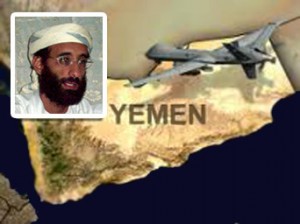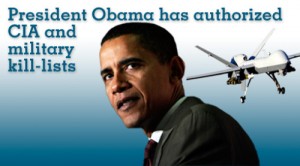Editor’s Note – The killing of Anwar al Awlaki and another US citizen, Samir Kahn by the CIA has raised questions of the legality of our government assassinating one of its citizens because he was a known terrorist operative/leader in 2011. Two questions arose.
The first was the legality of making that order, the second was whether or not it was legal for the CIA to carry out the deed. A third issue arises as well – if it was legal in the United States, was it legal in the land it was carried out in; Yemen?
Naturally, constitutional and international legal and diplomatic questions arose and many asked the Obama Administration for its legal explanation for coming to the conclusions they did and then relied upon when carrying out the assassination.
Congress demanded the rationale from Obama’s Department of Justice and just recently, the second of two documents were released finally. The first was released last year on the legality of the killing itself, and now the second provides the rationale for the CIA carrying out the order. Vice News provides us with the details below and the document can be read from a copy of the original.
You be the judge:
A Justice Department Memo Provides the CIA’s Legal Justification to Kill a US Citizen
By Jason Leopold – Vice News
“This white paper sets forth the legal basis upon which the Central Intelligence Agency (CIA) could use lethal force in Yemen against a United States citizen who senior officials reasonably determined was a senior leader of al-Qaida or an associated force of al-Qaida.”
So begins a 22-page, heavily redacted, previously top-secret document titled “Legality of a Lethal Operation by the Central Intelligence Agency Against a US Citizen,” which provides the first detailed look at the legal rationale behind lethal operations conducted by the agency. The white paper [pdf below] was turned over to VICE News in response to a long-running Freedom of Information Act (FOIA) lawsuit against the Justice Department.
It’s one of two white papers the Justice Department prepared in 2011 after lawmakers demanded to know what the administration’s legal rationale was for targeting for death the radical Muslim cleric Anwar al-Awlaki, a US citizen. The first white paper, released last year, addressed why the targeted killing by the US military of an American abroad was lawful. This second white paper addresses why it was lawful for the CIA to do so. Neither white paper identifies Awlaki by name.
The May 25, 2011 document is based on a 41-page Justice Department memo that lays out the government’s legal basis for targeting Awlaki without affording him his right to due process under the US Constitution. For years, the Obama administration was pressured by lawmakers to share the memo, but officials refused — and wouldn’t even confirm that such a memo existed.
One of the most controversial legal arguments advanced in the white paper is the justification for civilians at the CIA engaging in hostilities abroad. The 1942 Supreme Court decision in Ex Parte Quirin, which is footnoted in the white paper, says that “by universal agreement and practice, the law of war draws a distinction… between those who are lawful and unlawful combatants.
“[A]n enemy combatant who without uniform comes secretly through the lines for the purpose of waging war by destruction of life or property” is an example of a belligerent who is an “offender against the law of war subject to trial and punishment by a military tribunal.”
‘They clearly realize they needed to come up with their independent justification of why [the CIA] has public authority to kill.’
Because CIA personnel are not part of the armed forces when they engage in hostilities, they are deemed to be unlawful combatants. The white paper acknowledges this, but argues that the CIA officers who are unlawful combatants are not war criminals as long as they comply with the laws of war.
The government is “very concerned with the status of the CIA,” said international law expert Kevin Jon Heller, a professor of criminal law at the School of Oriental and Criminal Studies at the University of London. “There’s absolutely no question that if any of these CIA agents involved in Anwar al-Awlaki’s killing ever went on vacation in Yemen or ever went on vacation in a state that has universal jurisdiction over war crimes, they could be arrested and prosecuted for murder. They certainly have committed murder under the laws of other states. Whether they have committed murder under American domestic law is another question.”
The white paper outlines five possible legal authorities that might prohibit the CIA from using lethal force against a US citizen abroad: three statutes (the foreign murder statute, conspiracy to murder an individual outside the US, and the War Crimes Act) and two constitutional provisions (the Fourth Amendment, which prohibits unreasonable searches and seizures, and the Fifth Amendment, which guarantees due process).
It relies on the 2001 Authorization to Use Military Force (AUMF) and the relatively unknown legal doctrine known as the “public authority justification” to explain why the CIA’s actions are not unlawful, concluding that there is no law prohibiting the CIA from killing a US citizen in Yemen based on the facts of his particular case — redacted from the white paper — described by the CIA to the Justice Department.
Individuals typically use the public authority justification in criminal cases, arguing that the government authorized their actions. For example, a person wearing a wire for the FBI might be violating a state’s eavesdropping law. However, if the defendant successfully uses the public authority justification, he would not be found guilty even though he clearly violated the law. The white paper concedes that the public authority justification has rarely, if ever, been used to justify the government’s own acts.
%CODE%
Heller says he agrees with the legal analysis of the public authority justification, but only as it pertains to the military’s lethal actions abroad — not the CIA’s.
According to the white paper: “Given the assessment that an analogous operation carried out pursuant to the AUMF would fall within the scope of the public-authority justification, there is no reason to reach a different conclusion for a CIA operation.”
 Heller told VICE News this is the “sum total” the white paper says about the CIA’s public authority justification, and that the government falls short of making its case. Still, he says, the white paper is significant “as it indicates [the Justice Department] knew they had to talk about the CIA specifically, and knew they couldn’t just lump in the military and the CIA together.
Heller told VICE News this is the “sum total” the white paper says about the CIA’s public authority justification, and that the government falls short of making its case. Still, he says, the white paper is significant “as it indicates [the Justice Department] knew they had to talk about the CIA specifically, and knew they couldn’t just lump in the military and the CIA together.
“They clearly realize they needed to come up with their independent justification of why [the CIA] has public authority to kill,” Heller continued. “Unfortunately, the memo doesn’t really tell us anything because of the way it’s been redacted. If the question is, Where does the CIA get their authority to use lethal force abroad?, given that’s the necessary condition for them to avoid this foreign murder statute, this memo doesn’t tell us anything. It could be there. But if it is, it’s behind a redaction.”
Although the white paper says that the CIA expressed to the Justice Department that it preferred to capture “this target,” the agency assessed that a capture operation in Yemen “would not be feasible at this time.”
“The CIA has further represented that this sort of operation would not be undertaken in a perfidious or treacherous manner,” the white paper says.
A footnote states that the white paper “addresses exclusively the use of force abroad, in the circumstances described herein. It does not address legal issues that the use of force in different circumstances or in any nation other than Yemen might present.”
Still, the logic and legal rationale could be applied to the same types of lethal operations against Americans in other countries who the government may determine are part of al Qaeda or an “associated force” of the terrorist organization.


